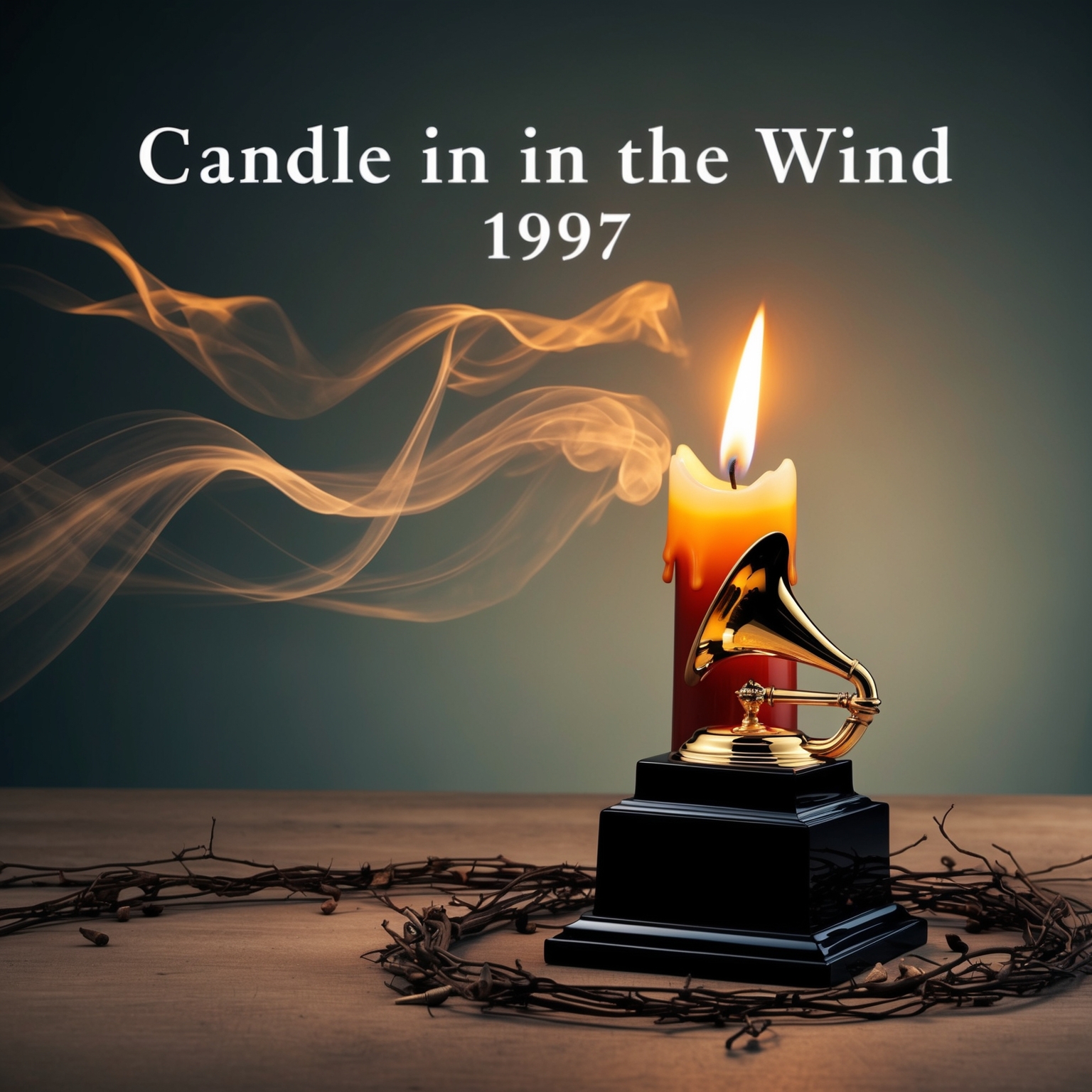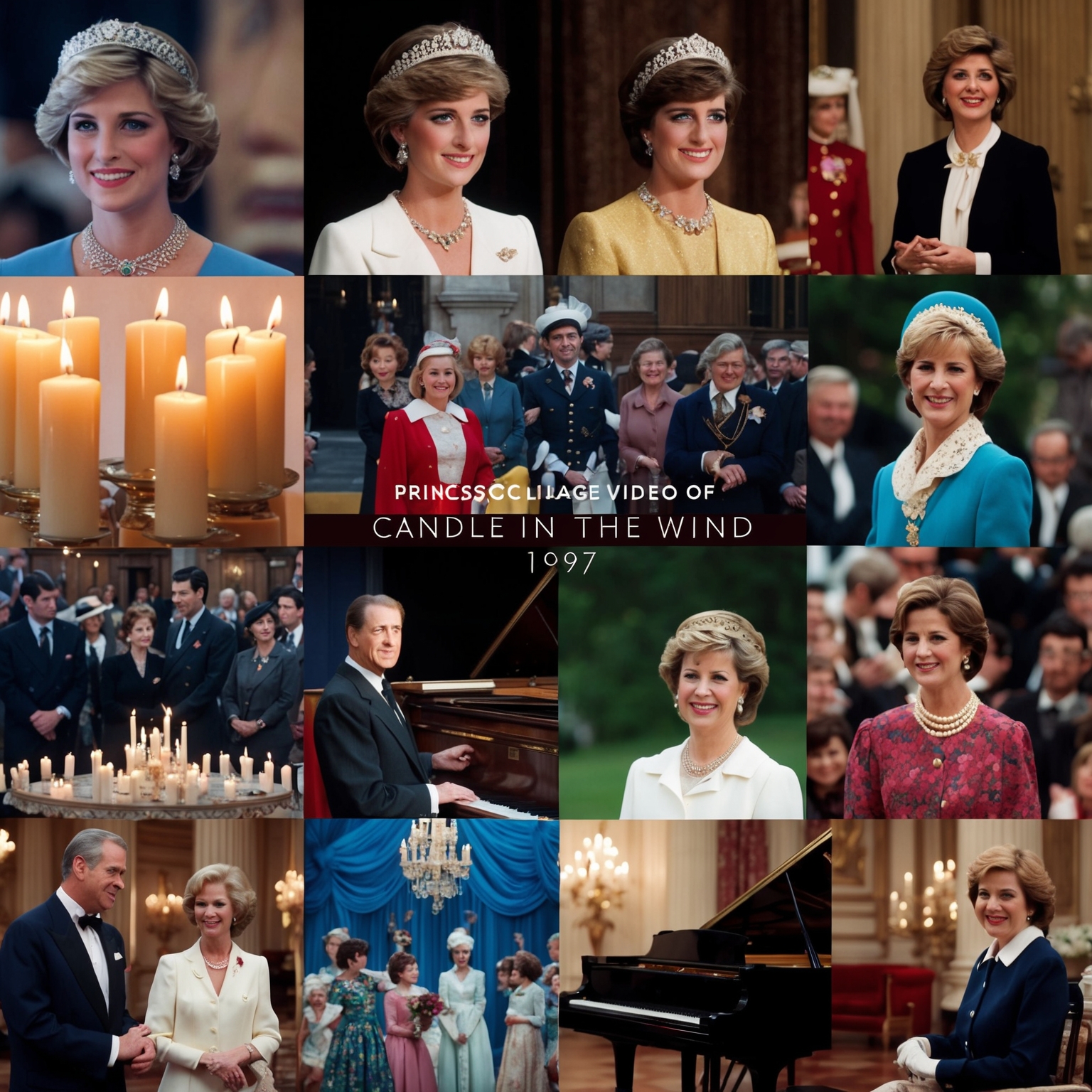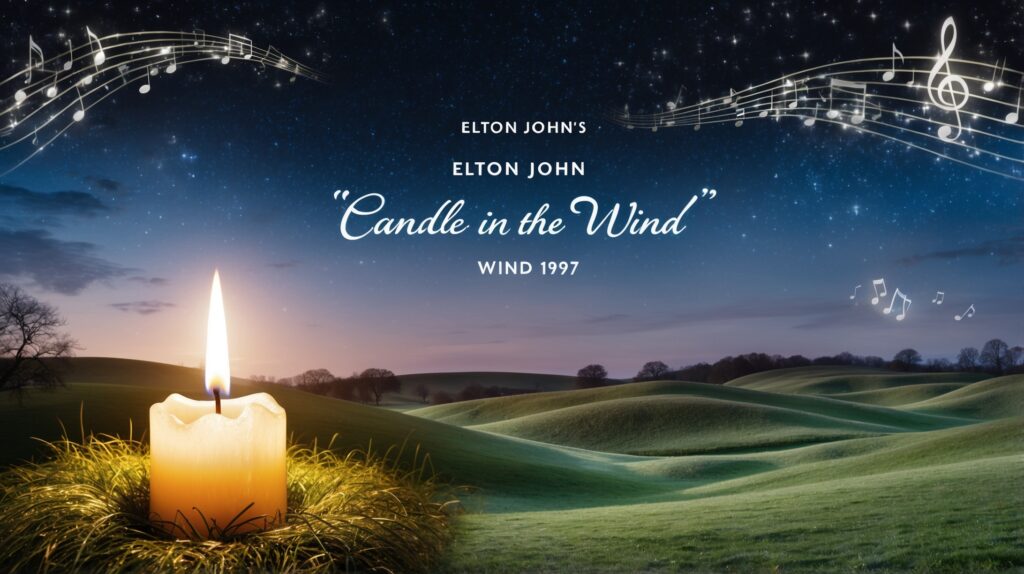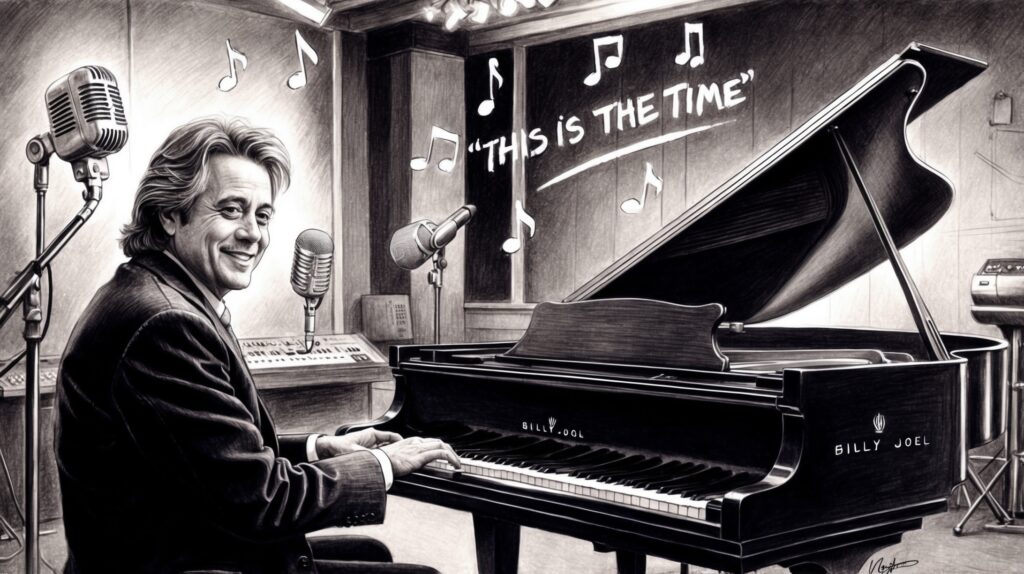Elton John: The Maestro Behind the Melody
Discover the life and legacy of Elton John, the legendary musician behind ‘Candle in the Wind 1997.’ From his early days to his iconic tribute to Princess Diana, explore his significant impact on the music world.

Elton John is an artist whose contributions to music extend far beyond his array of hits. With “Candle in the Wind 1997,” he demonstrated an ability to recreate and reinvent his music, adapting it to fit the emotional needs of the time. The song is a tribute to Princess Diana, and it holds the distinctive honor of becoming one of the best-selling singles of all time. Its significance in Elton John’s career cannot be overstated, as it showcases his knack for blending heartfelt emotion with universal appeal.
Born Reginald Kenneth Dwight in Pinner, England, Elton John showed musical promise at an early age. His career began in earnest in the mid-1960s, when he formed part of the songwriting duo with lyricist Bernie Taupin. Their partnership became legendary, marked by a creative synergy that brought forth classics like “Your Song,” “Rocket Man,” and “Tiny Dancer.” By the time “Candle in the Wind 1997” was released, Elton had already established himself as a towering figure in the music industry, known not just for his musical talents, but his showmanship and flamboyant persona.
The era surrounding the release of “Candle in the Wind 1997” was a transformative period for Elton John. In the 1990s, he saw a resurgence in popularity through various collaborations and adaptions. The alteration of the original 1973 “Candle in the Wind” highlighted his ability to remain relevant and impactful in changing times. Already regarded as an icon by his peers and music lovers alike, his tribute to Princess Diana became a standout moment that underscored his human touch in a career filled with glamour and genius.
The Genius Behind the Melody: Elton John’s Musical Craftsmanship
Discover the musical brilliance of Sir Elton John, the composer behind ‘Candle in the Wind 1997.’ From his eclectic influences to his innovative style, explore how his profound talent shaped this iconic tribute.

Background and Career: At the heart of ‘Candle in the Wind 1997’ lies the remarkable artistry of Sir Elton John, an iconic musician and composer celebrated for his profound impact on the music industry. Born Reginald Kenneth Dwight in 1947, Elton John’s journey into music began at an early age, characterized by an exceptional ability in piano playing. He honed his craft at the Royal Academy of Music, setting a solid foundation for a stellar career that has spanned over five decades. His unique blend of pop, rock, and classical elements established him as one of the most versatile composers of the 20th century. Elton’s career has been adorned with numerous accolades, including multiple Grammy Awards and induction into the Rock and Roll Hall of Fame, acknowledging his influence and innovation.
Musical Style and Influences: Elton John’s musical style is marked by its eclecticism, effortlessly weaving together pop sensibilities with rock intensity and a dash of theatrical flair. His influences range from the rhythmic charm of rock and roll pioneers like Little Richard to the melodic structures reminiscent of classical composers such as Ludwig van Beethoven. This amalgamation of influences results in compositions that are both commercially appealing and artistically sophisticated. In ‘Candle in the Wind 1997,’ Elton employed his trademark piano-driven melody to evoke deep emotional resonance, creating a song that transcends mere tribute.
Role in the Song’s Creation: Elton John’s role in the creation of ‘Candle in the Wind 1997’ was pivotal. Originally written in 1973 in homage to Marilyn Monroe, the song saw a transformative revision after the tragic passing of Princess Diana. Collaborating with his long-time lyricist partner, Bernie Taupin, who crafted poignant new lyrics, Elton composed an arrangement that was both solemn and uplifting. His use of poignant chord progressions and emotive piano lines amplified the lyrical tribute, reinforcing the song’s intent as a farewell to a beloved public figure. This composition highlights Elton’s ability to harness music’s emotive power, creating a piece that resonated across the globe.
Triumphs and Tributes: The Recognition of ‘Candle in the Wind 1997’
Explore the global impact of ‘Candle in the Wind 1997’ through its numerous accolades, covers by other artists, and its enduring presence in memorial events.

‘Candle in the Wind 1997‘ by Elton John is a song that transcended music charts to become a cultural phenomenon recognized at prestigious award ceremonies. Released as a tribute to Princess Diana, the song resonated worldwide, earning numerous awards and accolades. It was notably awarded the Grammy Award for Best Male Pop Vocal Performance in 1998, highlighting Elton John’s profound emotional delivery. Additionally, it was named the Best-Selling Single According to the Guinness Book of Records in 1997, selling over 33 million copies globally at the time.
Several artists have paid homage to ‘Candle in the Wind 1997’ through their own renditions, although it’s a challenging act to follow given its iconic status. While covers may not parallel the original’s impact, they reflect its enduring legacy in the music world. This song’s timeless appeal has allowed it to be revisited by performers across generations, underlining its lasting impression.
Although the song is not typically associated with movies, games, or television shows, its presence is felt profoundly in memorial services and tribute events. Its poignant melody and thoughtful lyrics make it a fitting choice for occasions of reflection and remembrance, further solidifying its place in popular culture. Overall, ‘Candle in the Wind 1997’ is more than just a song; it’s a lasting tribute that continues to touch hearts and garner recognition globally.
A Resounding Triumph on Global Charts
Explore the monumental chart success of “Candle in the Wind 1997,” a song that topped global charts, broke records, and defined Elton John’s enduring legacy.

“Candle in the Wind 1997” by Elton John is monumental not just for its poignant tribute, but also for its unprecedented chart success. Released on September 13, 1997, the song rapidly ascended the charts, capturing the hearts of millions worldwide. It didn’t just make a strong debut; it soared to the top, claiming the number one position in numerous countries. Its impact was immediate and profound, marking the single as one of the best-selling songs of all time.
In the U.S., “Candle in the Wind 1997” debuted at number one on the Billboard Hot 100, where it remained for 14 consecutive weeks, a record-setting feat that showcased its widespread appeal. Its performance was similarly impressive in the UK, where it topped the charts for five weeks and became the fastest-selling single in British history at the time. This tremendous success painted a clear picture of its powerful resonance with audiences across various demographics and geographical lines.
Critical acclaim showered the single with further recognition, securing its legacy in music history. The heartfelt tribute, initially composed to honor Marilyn Monroe and later reimagined for Diana, Princess of Wales, struck a deep chord with fans and critics alike. The song became a significant cultural touchstone, influencing the trajectory of Elton John’s career by solidifying his status as not just a pop icon but a legendary artist dedicated to meaningful artistry. Through strategic promotion and Elton’s heartfelt performances, “Candle in the Wind 1997” remains a triumph of the late 20th century’s music landscape.
A Unique Tribute: The Unseen Video Interpretations
Explore the creative visual interpretations surrounding “Candle in the Wind 1997,” which highlight its emotional depth and role as a tribute to Princess Diana.

While Elton John’s poignant rendition of “Candle in the Wind 1997” doesn’t have an official music video, the song has inspired a plethora of fan-made videos and live performance compilations that capture its emotional essence. These unofficial visuals often showcase a heartfelt tribute to Diana, Princess of Wales, as the song was famously rewritten to commemorate her life. Often employing archival footage and personal photographs of the beloved figure, these videos aim to evoke the same love and admiration that Elton John’s version encapsulates so deeply.
Many fans have taken the liberty to create videos filled with montages of Princess Diana’s public appearances, charitable endeavors, and moments with her family. These clips offer a visual journey that complements the song’s reflective lyrics about a life lost too soon, emphasizing the nostalgia and collective mourning felt by those who cherished her. By adding their own creative touches, fans have ensured that the song’s message of remembrance continues to resonate through these visual interpretations.
Additionally, Elton John’s live performances of “Candle in the Wind 1997,” notably his moving interpretation at Princess Diana’s funeral, have been widely shared and viewed online. These live renditions further solidify the song’s deep emotional impact. The stark simplicity of John at the piano, juxtaposed with the unadorned elegance of the church setting, contributes significantly to the song’s enduring legacy. This combination of unofficial visuals and live performance clips affirms the song’s role as an eternal tribute, preserving the memories of an icon through music and imagery.
Analyzing the Intricacies of ‘Candle in the Wind 1997’
Explore the intricate musical structure of ‘Candle in the Wind 1997,’ from its key and chord arrangements to the instrumental and rhythmic elements that make it an enduring tribute.

‘Candle in the Wind 1997,’ performed by Elton John, is a heartfelt tribute with a rich musical structure. Primarily, the song is written in the key of E-flat major, a choice that envelops the listener in a lush, warm sound. This key contributes to the song’s reflective and meditative qualities, effectively complementing the poignant lyrics.
The chord structure is straightforward yet effective, primarily featuring chords such as E-flat, B-flat, A-flat, and C minor. This simplicity allows the emotive lyrics and John’s vocal delivery to shine. The tempo of the song is a measured and solemn 76 beats per minute, which evokes a sense of reverence and remembrance typical of a tribute piece.
The melody of ‘Candle in the Wind 1997’ is both haunting and soothing, capturing the essence of remembrance that Elton John intended. The harmonies are subtle yet powerful, achieved through John’s seamless vocal delivery. Rhythmic elements are gently understated but play a crucial role in maintaining the song’s reflective tone.
Instrumentally, the song predominantly features the piano, which is Elton John’s signature instrument and plays a pivotal role in delivering its emotional depth. Additionally, strings and woodwinds add a layer of sophistication and melancholy, enhancing the overall atmosphere. The arrangement ensures that no instrument overshadows the vocals, maintaining a delicate balance.
Within the context of Elton John’s discography, ‘Candle in the Wind 1997’ marks a poignant departure from his more upbeat and flamboyant tracks. Compared to his earlier works, this song highlights a matured artistic direction, emphasizing theme over grandeur. This transition signifies John’s evolution as an artist willing to embrace solemn themes and allows listeners to see a different dimension of his musical prowess.
An interesting fact about the recording of ‘Candle in the Wind 1997’ is that it was produced by George Martin, often referred to as the ‘Fifth Beatle’ for his legendary work with The Beatles. The session was conducted with a sense of reverence, mirroring the song’s sentiment. Anecdotes from the recording sessions depict a deeply emotional set, with the feeling of immense responsibility to honor Princess Diana’s memory adding an indelible weight to the creative process.
A Heartfelt Eulogy Through Melody
The lyrics of ‘Candle in the Wind 1997’ weave a heartfelt tribute to Princess Diana, exploring themes of loss, remembrance, and admiration. Using metaphors and poignant storytelling, the song captures her fleeting yet impactful legacy, resonating globally.
May you ever grow in our hearts
You were the grace that placed itself
Where lives were torn apart
You called out to our country
And you whispered to those in pain
Now you belong to heaven
And the stars spell out your name
And it seems to me you lived your life
Like a candle in the wind
Never fading with the sunset
When the rain set in
And your footsteps will always fall here
Along England’s greenest hills
Your candle’s burned out long before
Your legend ever will
Loveliness we’ve lost
…
******* This Lyrics is NOT for Commercial use *******
 Lyrical Themes and Messages: The lyrics of ‘Candle in the Wind 1997’ present a poignant tribute to Princess Diana, capturing the themes of loss, remembrance, and admiration. Written as a eulogy, the song embodies a deep sense of mourning yet celebrates Diana’s enduring legacy. The themes are deeply personal and resonate universally by acknowledging the dichotomy of public adulation and private struggles—a reflection of the extraordinary life Diana led. The metaphor of a ‘candle in the wind’ signifies the frailty and briefness of life, while highlighting the indelible impact she had on the world, forever etched in the hearts of many.
Lyrical Themes and Messages: The lyrics of ‘Candle in the Wind 1997’ present a poignant tribute to Princess Diana, capturing the themes of loss, remembrance, and admiration. Written as a eulogy, the song embodies a deep sense of mourning yet celebrates Diana’s enduring legacy. The themes are deeply personal and resonate universally by acknowledging the dichotomy of public adulation and private struggles—a reflection of the extraordinary life Diana led. The metaphor of a ‘candle in the wind’ signifies the frailty and briefness of life, while highlighting the indelible impact she had on the world, forever etched in the hearts of many.
Narrative and Storytelling: The narrative style unfolds in an elegiac manner, employing a third-person perspective that seamlessly blends personal and public sentiments. This stylistic choice enhances the collective mourning expressed and immerses the listener into a shared space of grief and reverence. The story that’s told is not bound by a strict chronological timeline but instead weaves emotions and images, making the song a timeless dedication. The invocation of England’s landscapes also establishes a strong cultural connection, tying her spirit to the nation and its history.
Use of Literary Devices: Elton John’s lyrics masterfully employ metaphors such as the iconic ‘candle in the wind’ to evoke imagery of both resilience and vulnerability. The alliteration in phrases like ‘England’s rose’ adds lyrical beauty, while the rhyme scheme lends a musical fluidity that complements the gentle piano-driven melody. The lyrical devices serve not only as a tribute but also as an invitation for listeners to partake in a collective catharsis, allowing them to embrace their own memories and emotions surrounding Diana’s legacy.
Cultural and Social References: Laden with cultural and historical references, the lyrics cement Diana’s role as a universal figure of compassion and grace. Her untimely death marked a poignant moment in global history, and the song reflects the social consciousness that enveloped her life and the outpouring of grief following her passing. Different audiences perceive these references through various lenses, creating a multifaceted experience that underscores Diana’s influence across cultural boundaries. This universality in connection is part of what made the song so effectively resonate with people worldwide.
Emotional Impact and Relatability: Emotionally, the lyrics strike a chord with listeners, drawing upon shared feelings of loss and admiration. The simple yet profound language allows for relatability, and as such, ‘Candle in the Wind 1997’ became an anthem of mourning not just for Diana, but as a more general reflection on the fleeting nature of life and legacy. The emotional resonance is one of the key reasons the song achieved such widespread acclaim, creating a lasting impact within popular culture. Beyond merely listening, audiences feel the weight of the words, experiencing a powerful connection that transcends music.
🎹 Did you know Candle in the Wind 1997 became the best-selling single in history, selling over 33M copies? 🎤 Elton’s heartfelt tribute to Diana is timeless! 🌟 #EltonJohn #CandleInTheWind #MusicHistory #FunFact https://bit.ly/48o0TKB
Click to Tweet







